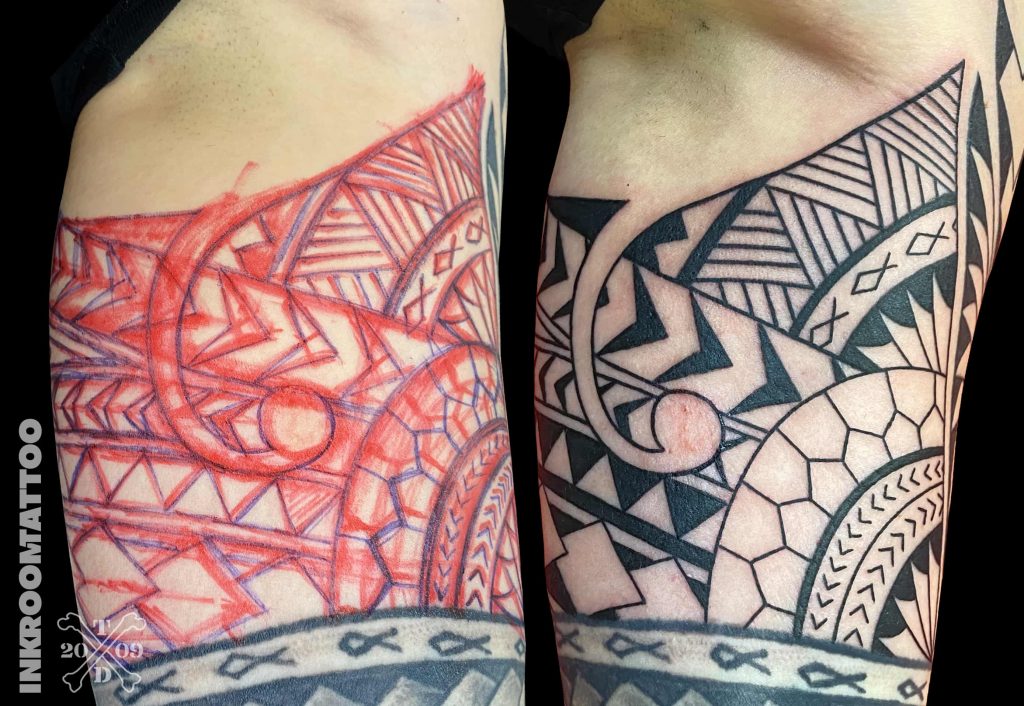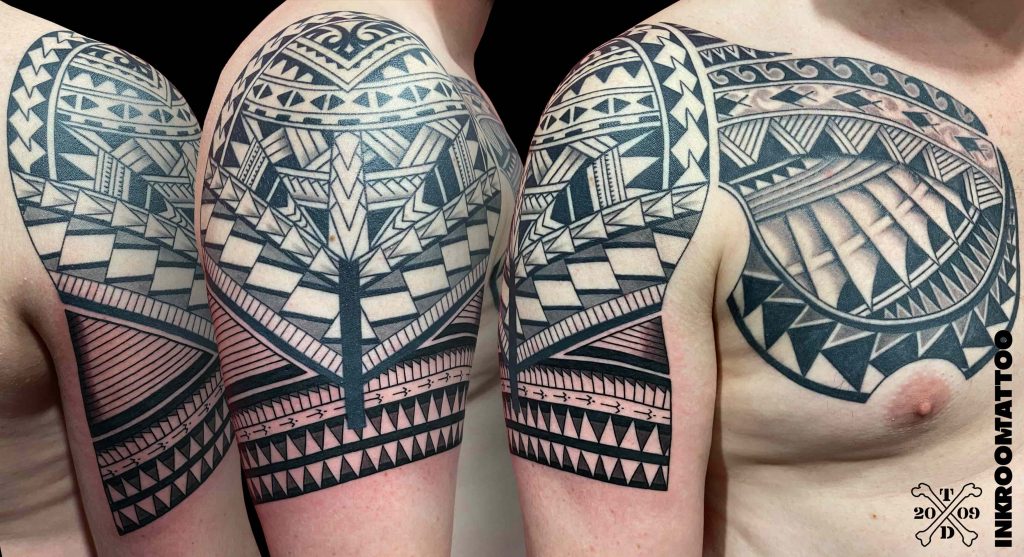Maori Tattoo
Before diving into the history of Maori tattooing, it’s important to clarify the difference between Maori and Samoan tattoos. Simply put, there are more similarities than differences.
Together, they form the broader category of Polynesian tribal tattoo style.
Maori designs are known for their flowing, spiral motifs, while Samoan tattoos are characterized by clean lines and geometric shapes, most commonly placed on the buttocks and legs.
In traditional Maori culture, the face was the main focus of tattooing. Men often had their entire faces tattooed, while women typically decorated only their chins, lips, and nostrils. Some Maori also had tattoos on their backs, buttocks, and legs, while women more often tattooed their arms, necks, and thighs.
These tribal tattoos are never made using stencils. After choosing the motifs, the tattoo artist draws them freehand, carefully following the individual’s muscle and bone structure.
Each symbol – even the smallest lines – holds significance, and together they tell a story, sometimes representing an entire life. Traditional tribal tattoos reflect the wearer’s rank, achievements, and social status.

The History of Polynesian Tattooing
Polynesia is part of Oceania and consists of thousands of islands, including Australia and New Zealand. Its cultures are diverse, but tattooing is a shared tradition across the region.
It was Captain James Cook’s expedition that introduced the word tattoo into the English language, derived from the Polynesian word tatau.
When Cook and his crew encountered Polynesians, they realized each tribe used tattoos in different ways. For instance, the Maori wore facial tattoos (Ta Moko), while other groups like the Marquesans had full-body tattoos in intricate styles.
When they met the Samoans, Cook’s crew considered them “civilized” due to the “silk garments” they appeared to wear below the waist. They soon realized it wasn’t clothing, but a tattoo called pe’a, worn by Samoan men. It began at the navel, extended down the thighs, and wrapped around the lower back.
This shocking discovery introduced Western sailors to a sacred Polynesian art form that had existed for thousands of years. Some believe this tattoo style was brought to the region by early Southeast Asian ancestors who migrated and settled on the islands.
Many sailors fell in love with the style. Some got tattooed while visiting the islands, while others were tattooed by amateur artists aboard their ships using local tools and patterns. They returned home with tribal-style tattoos, sparking a new wave of tattoo art in the Western world.
Maori tattoos are incredibly complex. Traditionally, no needles were used. Instead, they relied on tools made from shark teeth, sharpened bones, or stones. These chisels (uhi) could be smooth or serrated, and were used depending on the desired design.
The inks were made entirely from natural materials. Burned wood was used to produce black pigment, while lighter pigments were made from caterpillars infected with a particular fungus or from burnt kauri gum mixed with animal fat. These pigments were stored in intricately decorated containers called oko, which were considered family heirlooms and were often buried when not in use.
Black pigment from burnt wood was reserved exclusively for facial tattoos, while other pigments were used for outlines or less sacred tattoos. Before tattooing, the tohunga ta moko (tattoo master) would carefully examine the person’s facial structure to decide on the most suitable design. No two Maori tattoos are ever the same.
Even today, tribal tattoos are in high demand – although modern tattoo studios no longer use the traditional tools and techniques.
Blackwork style also draws heavily from the art of tribal tattooing.

Common Maori Designs and Their Meanings
Te Ora O Maui Design
This design represents Maui’s fishing expedition or the discovery of Aotearoa – the Maori name for New Zealand.
Pikorua Design
Pikorua means the growth and intertwining of two separate entities, such as land and sea.
It reflects the belief that we all walk different paths in life but ultimately end up in the same place. It symbolizes life’s journey and spiritual connection.
Nga Hau E Wha Design
This design represents the four corners of the Earth and the four winds (nga hau e wha).
It encourages respect for the gifts of nature and symbolizes that Aotearoa is a place for people of all races and faiths. Tamanuite-rā represents warmth and growth, Hei Matua symbolizes strength and prosperity, while the koru reflects continuity.
Popular Standalone Maori Motifs
Koru (Spiral):
Represents new beginnings, growth, and harmony, inspired by the shape of an unfurling fern. Spirals can symbolize family members or loved ones.
Hei Matau (Fish Hook):
Symbolizes prosperity, strength, determination, and good health. It’s also believed to bring safe travel over water.
Single Twist:
Represents life’s path and is a symbol of eternity.
Double or Triple Twist:
These designs represent the connection between people, cultures, or groups for eternity. Even through life’s ups and downs, the bond remains strong. Twists are popular Maori symbols that represent infinite, unbreakable connections.
Maori Turtle Tattoo:
Turtles symbolize travel and navigation. Other meanings include fertility, longevity, peace, and unity.


